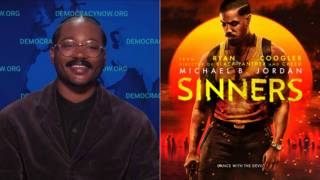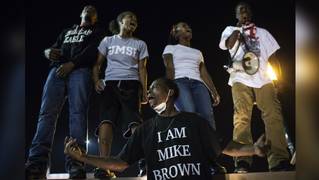
Topics
By Amy Goodman with Denis Moynihan
Thousands have been protesting the police killing of Michael Brown, an unarmed African-American teenager in the St. Louis suburb of Ferguson. He was due to start college just days after he was shot dead in broad daylight. Police left his bleeding corpse in the middle of the street for over four hours, behind police tape, as neighbors gathered and looked on in horror. Outraged citizens protested, and police brutally cracked down on them. Clad in paramilitary gear and using armored vehicles, they shot tear gas, rubber-coated steel bullets and flash-bang grenades, aiming automatic weapons at protesters. Scores of peaceful protesters, as well as journalists, have been arrested.
The protests have raged along Ferguson’s West Florissant Avenue. Four miles south of the protest’s ground zero, along the same street, in the quietude of Calvary Cemetery, lies Dred Scott, the man born a slave who famously fought for his freedom in the courts. The Dred Scott decision of 1857 is considered by many to be the worst one in the history of the U.S. Supreme Court. It ruled that African-Americans, whether slave or free, could not be citizens, ever.
Scott was born into slavery in Virginia around 1799 (the same year noted Virginia slaveholder President George Washington died). Scott’s owner moved from Virginia, taking him to Missouri, a slave state. He was sold to John Emerson, a surgeon in the U.S. Army. In 1847, Scott sued Emerson for his freedom in a St. Louis court. Scott and his family prevailed, winning their freedom, only to have the decision overturned by the Missouri Supreme Court. The case then went to the U.S. Supreme Court.
In the court’s majority opinion, Chief Justice Roger Taney, a supporter of slavery, wrote, “A free negro of the African race, whose ancestors were brought to this country and sold as slaves, is not a ‘citizen’ within the meaning of the Constitution of the United States.” Thus, the court ruled that all African-Americans, whether slave or free, were not citizens, and never would be.
The ruling also declared the Missouri Compromise unconstitutional. The compromise made Missouri a slave state, but dictated that northern territories in the rapidly expanding United States would be free territories, with slavery outlawed. The Dred Scott decision opened up all of these new territories to slavery, and was deemed a victory for the Southern slave states. The decision sent shockwaves through the country. Abraham Lincoln invoked the decision in his famous “House Divided” speech, saying: “A house divided against itself cannot stand. I believe this government cannot endure, permanently half slave and half free.” The Dred Scott decision would help lead to the election of Lincoln as president, and push the country ever closer to civil war.
Professor john a. powell (who writes his name in lower-case letters) teaches courses on Dred Scott. He is a professor of law and African-American studies at the University of California, Berkeley, and sees a link between that awful decision and problems today. “We still have not come to full recognition of blacks and other people as full citizens, as full people,” he told me. The protests in Ferguson stem in part, he says, because “the black community tends to be overpoliced and unprotected.”
Ferguson is emblematic of deep racial divisions that persist in the United States today. Since the 1980s, the city has shifted from a majority white population to one that is majority black. Yet the mayor is white. The city council is overwhelmingly white, as is the school board. Perhaps most relevant to the protests, 50 officers of the 53-member police force are white as well. Pastor Michael McBride of Berkeley, Calif., has been in Ferguson, organizing the community in the aftermath of Michael Brown’s killing. Standing just feet from a military-grade Humvee, he blamed the systemic police violence on “irrational fear of black men … if you’re that scared of black men, you should not police black communities.”
The people of Ferguson demand justice for Michael Brown, including the arrest of Ferguson Police Officer Darren Wilson, who killed Brown. A number of groups are calling for a special prosecutor to take over the case, the removal of the National Guard and a Justice Department investigation into every shooting of an unarmed person of color
Dred Scott lost in court, but eventually gained his freedom from another owner. Sadly, Scott died a year later in 1858 of tuberculosis. Miles from his final resting place, the echoes of his life and his struggles persist, amidst clouds of tear gas.
Amy Goodman is the host of “Democracy Now!,” a daily international TV/radio news hour airing on more than 1,200 stations in North America. She is the co-author of “The Silenced Majority,” a New York Times best-seller.
© 2014 Amy Goodman
Listen and share Amy Goodman’s weekly podcast on SoundCloud.












Media Options